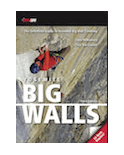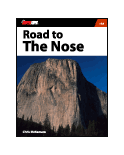This is part of the How to Big Wall Climb SuperTopo book. Videos like the ones above illustrate key points of the book and are meant to be watched while reading the book. Buy the book here or just read this free sample of the text below with photos.

Visit on supertopo.com
Anchor a free-hanging rope 20 to 30 feet up. The rope length is at least 200 feet.
Basic Following On Vertical and overhanging terrain
Brief intro
Ascending overhanging terrain is much more psychically demanding than low angle terrain. On low angle terrain you weight your legs. On overhanging terrain you must use your arms. The trick is to use you arms as little as possible.
Skills to learn
Gear You Need
Where to Practice
A vertical or overhanging wall at the climbing gym works well. Alternately, a 30 to 50-foot steep cliff works. I learned on a 20-foot-long horizontal tree branch in my back yard that worked okay.
Ascending a Vertical or Overhanging Wall
There are many techniques for jugging a free hanging rope or a steep wall. I have tried a bunch of them and they are all equally exhausting so I go with the simplest setup:
First, re-examine your daisy length; make sure it is not too long. You don’t want any weight on your top arm when you hang on the top Ascender. Experiment with a few different lengths to make sure you have it right.
1. Remove the top Aider from the top Ascender.
2. While on the ground, pull all the slack and stretch out of the rope so you can hang on the top Ascender.
3. Put your foot in the third step of an aid ladder or the second step of a standard Aider (this is on the Aider attached to the bottom Ascender)
4. In one motion, push with the foot in the bottom Aider and slide the top Ascender up.
5. Rest on the top Ascender (make sure the daisy is not too long. You want a bend in the elbow).
6. Push up the bottom Ascender until the top of the bottom Ascender is an inch or two below the bottom of the top Ascender.
7. Repeat.
Most pitches on a route like The Nose are not so overhanging that the whole time you are out in space. So I usually leave the top Aider on but DO NOT put my foot in it. Having a foot in the top Aider and the bottom Aider while jugging overhanging terrain is the fastest way to get tired on a big wall.
The most important thing is to rest entirely on the top daisy and not on your top arm at all. It helps to have the lightest weight locking biner possible on the top Ascender (I like the Trango SuperFly Screwlock ). If you want, ask a friend to show you the Frog technique or the Texas Kick but I have found these more exhausting than useful.
How to Jug Over a Lip
Jugging over a lip is tricky because the weight on the bottom Ascender pulls the rope tightly against the rock and makes it hard to pass the top Ascender. There are two techniques to deal with this. One is to take the top Ascender off the rope, pass it over the lip and clip it back on. If this is not possible, or you want to save time, there is a more subtle technique: in one fluent motion you pull away from the rock with both Ascenders and then pop the top Ascender up a couple inches. Often you can only move it up an inch at a time. After a few of these motions you should pull the lip.
Master Check List
Session 7
Where; set up a free hanging rope at a cliff, climbing gym or tree.
[ ] Jug once timing yourself to get a benchmark time
[ ] Jug ten times. Focus on smooth but consistent movement.
[ ] On the tenth repetition, time yourself and try get 50 to 75 percent faster than on your first benchmark time.
[ ] Adjust the length of daisy chain and go five times. Time the fifth one and compare it to the time before. Go with the daisy length that is most comfortable and gives the best time.
[ ] Adjust the height of your feet in the Aiders and go five times. Time the fifth lap and compare it to the time before. Go with the Aider height that is most comfortable and gives the best time.
[ ] Once you figure out the best place for your feet, do another ten laps. Time yourself on the last lap and try to get 25 percent faster than your tenth time.
[ ] Get a good arm pump.
[ ] Recover for two days.
[ ] Anchor a free-hanging rope 20 to 30 feet up. Have the rope length be at least 200 feet. Build your jugging muscles so they won't lock up with cramps on Day 3 of the big wall.
This is part of my How To Big Wall Climb project. View the Table of Contents






